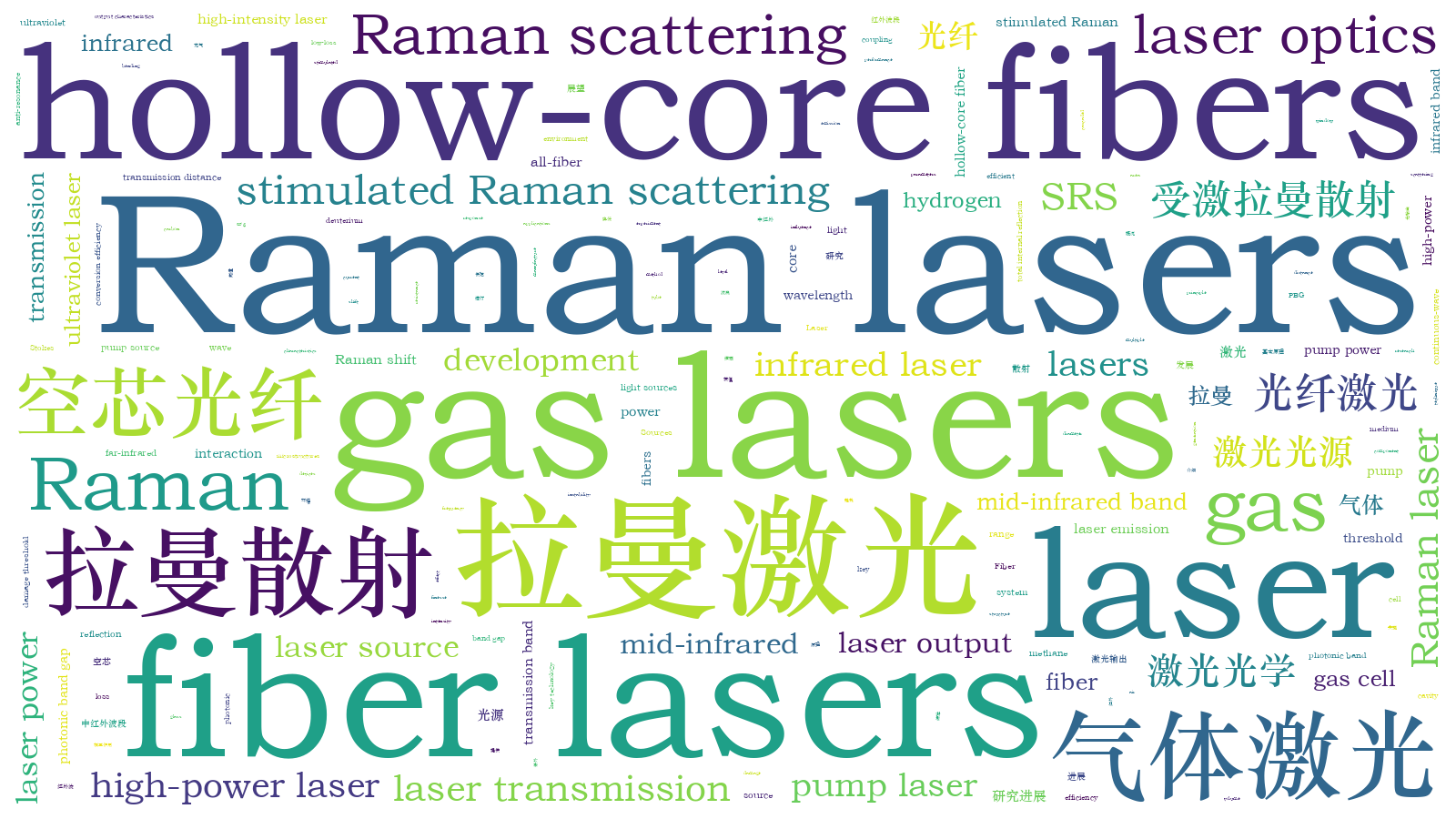光纤气体激光光源研究进展及展望(Ⅰ): 基于受激拉曼散射  下载: 1777次
下载: 1777次
Significance Since gas-stimulated Raman scattering (SRS) was first reported in 1963, it has been recognized as an effective method for extending laser wavelength range from the ultraviolet to infrared bands. However, the effective interaction length between laser and gas is limited, so the threshold for SRS in the traditional gas cavity is very high. Although some methods have been developed in which hollow-fiber capillaries and high-finesse cavities are adopted, the effective interaction length remains limited. This situation has not been improved until 1999 by the production of the first hollow-core fiber (HCF), which provides an ideal environment for the interaction of light and gases. The high-intensity laser is confined to the core area and continues to interact with the gas over a very long transmission distance, thus the effective interaction length is greatly increased. Because the transmission band of the HCF can be designed, it is easy to suppress those unwanted Raman lines and increase the power-conversion efficiency of the first-order Stokes wave, thus the production of efficient gas Raman lasers becomes possible. In 2002, Benabid et al. at the University of Bath conducted the first SRS experiment in a hydrogen-filled HCF, and a new era of fiber gas Raman lasers (FGRLs) is launched.
In the main text of this paper,
The HCF is a key component of the FGRLs, providing an ideal environment for gas SRS. The HCF performance parameters have a decisive influence on the laser output characteristics. For example, the transmission band range of the HCF affects the output laser wavelength, the transmission loss affects the Raman conversion efficiency, the core diameter affects the Raman threshold, the damage threshold affects the upper limit of Raman power, and the bending resistance affects the volume of the laser source system. Therefore, the recent rapid development of the HCF has greatly advanced the development of FGRLs. In general, the inside of the HCF contains air, and laser transmission in the HCF no longer meets the principle of total internal reflection. Two main mechanisms are involved: photonic band gap effect and anti-resonance reflection. Thus, HCFs can be roughly divided into two categories: photonic band gap hollow-core fibers (PBG-HCFs) and anti-resonance reflection hollow-core fibers (AR-HCFs). PBG-HCFs feature a relatively small core region and narrow transmission band, suitable for efficient rotational SRS generation. AR-HCFs feature multiple transmission bands, suitable for gas SRS with a large Raman shift and are mainly used in the mid-infrared region. The microstructures of AR-HCFs include the Kagome type, ice-cream type, nodeless revolver type, conjoined-tube type, and nested type.
Progress Since its introduction in 2002, the FGRL has been vigorously developed. Thus far, hydrogen, deuterium, methane and other gases have been used as Raman media to achieve laser output at various bands from ultraviolet to mid-infrared. The pure rotational SRS of hydrogen in HCF with 1.1μm output was reported in 2004. In 2007, researchers reported the development of a continuous-wave-pumped FGRL based on a hydrogen-filled HCF. In 2014, the 1.9μm FGRL based on hydrogen-filled HCFs was reported. In 2016 and 2017, 1.5μm FGRLs based on ethane-filled and methane-filled HCFs were reported, respectively. The 4.4μm FGRL based on hydrogen-filled HCFs was reported in 2017. In 2018, the SRS of deuterium in HCFs was reported. In the same year, the 2.8μm FGRL in a methane-filled HCF was achieved, and the cascaded system was proposed. In 2019, the SRS of carbon dioxide in HCFs was reported, and the SRS of SF6 and SF4 in HCFs was reported. In 2020, the 1.7μm FGRL based on a hydrogen-filled HCF was developed. The ultraviolet laser is typically generated by Raman frequency combs.
Conclusion and Prospects Although FGRLs have rapidly developed in response to the fast development of HCFs in recent years, research remains at the very initial developmental stage. Currently, the main problems are: the limitations imposed by the instability of the spatial structure on the practicality of FGRLs; the technique used to manufacture HCFs, especially AR-HCFs, which has not reached a commercial level; the lack of development of HCF-related devices; and the urgent need to resolve the low-loss coupling of the solid-core fiber and HCF. To resolve these problems, the development of FGRLs has four main future directions: 1) development of an all-fiber system for the practical use of FGRLs; 2) extension of the output laser wavelength to the mid-infrared or even far-infrared band to enable mature FGRLs to fill the current gap of fiber lasers in the mid-infrared band, especially that above 4μm will become an important mid-infrared laser source; 3) achievement of continuous-wave Raman laser emission, especially in the mid-infrared range; and 4) achievement of high-power laser output. With the key technology breakthrough of the all-fiber gas cavity, the realization of high-power all-fiber gas Raman lasers should greatly promote the development of these light sources toward their practical applications.
王泽锋, 黄威, 李智贤, 周智越, 崔宇龙, 李昊. 光纤气体激光光源研究进展及展望(Ⅰ): 基于受激拉曼散射[J]. 中国激光, 2021, 48(4): 0401008. Zefeng Wang, Wei Huang, Zhixian Li, Zhiyue Zhou, Yulong Cui, Hao Li. Progress and Prospects of Fiber Gas Laser Sources (Ⅰ) :Based on Stimulated Raman Scattering[J]. Chinese Journal of Lasers, 2021, 48(4): 0401008.







